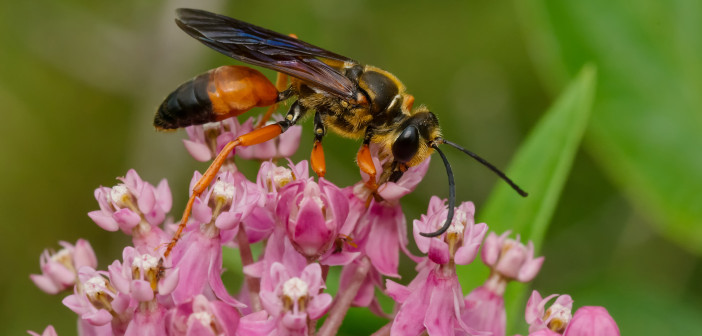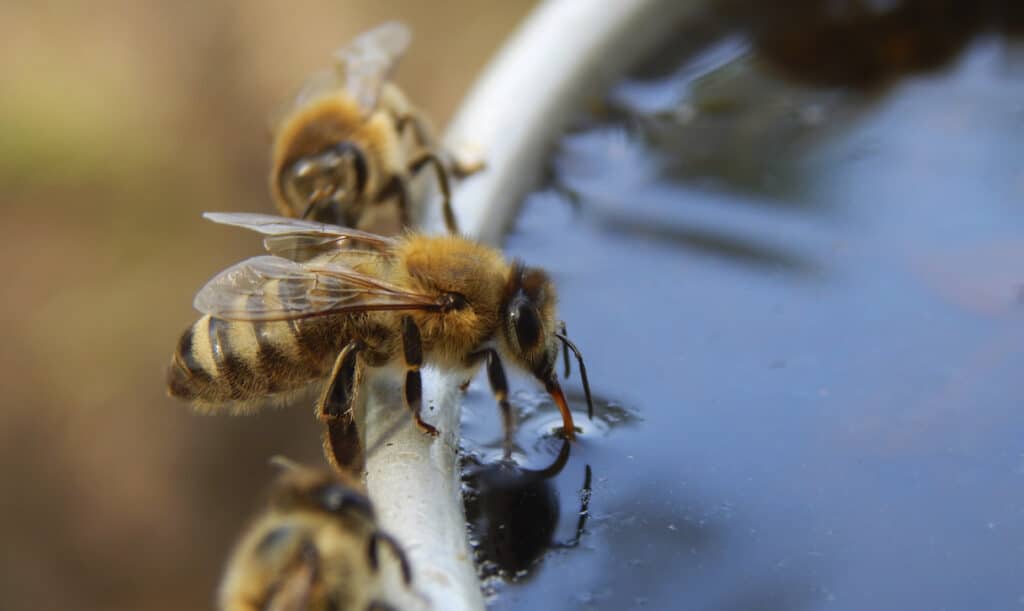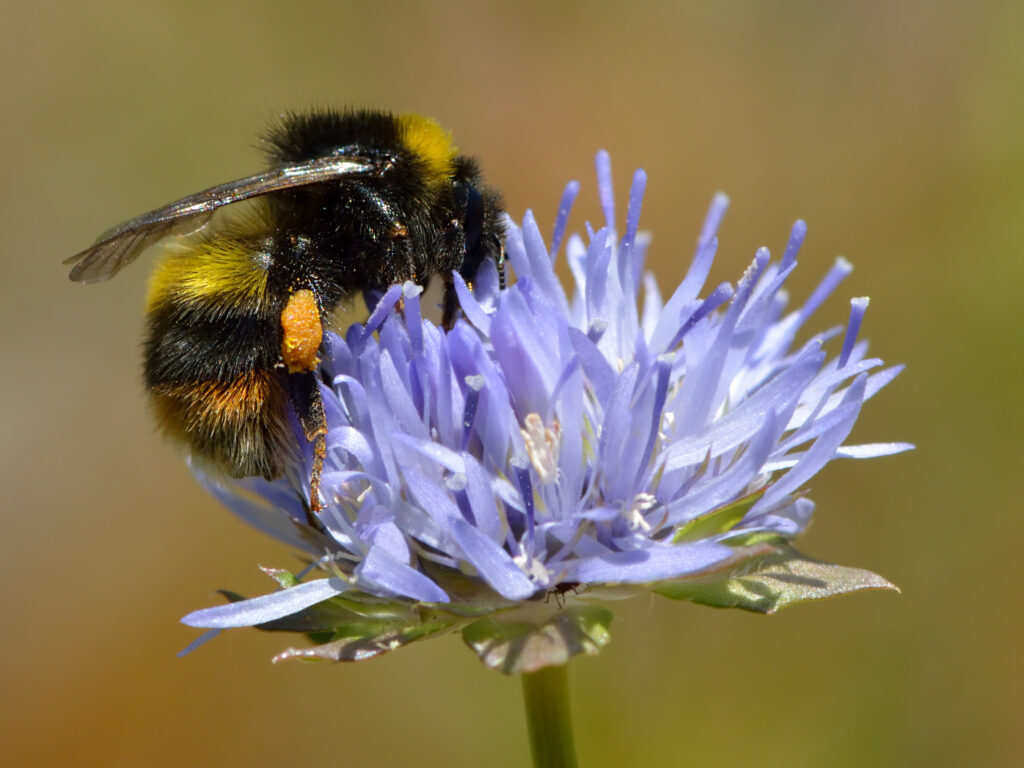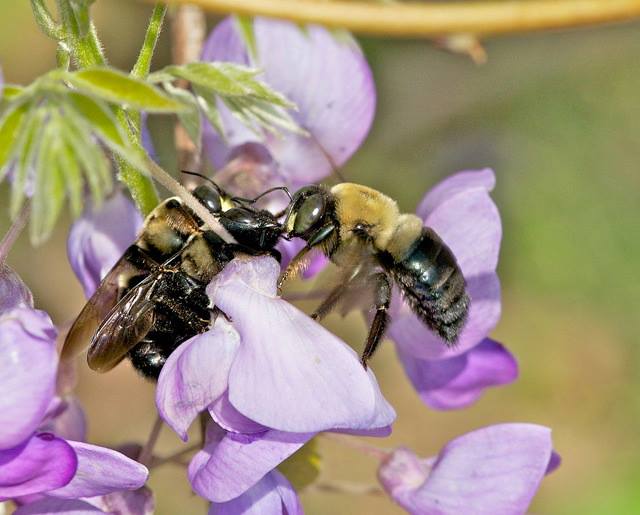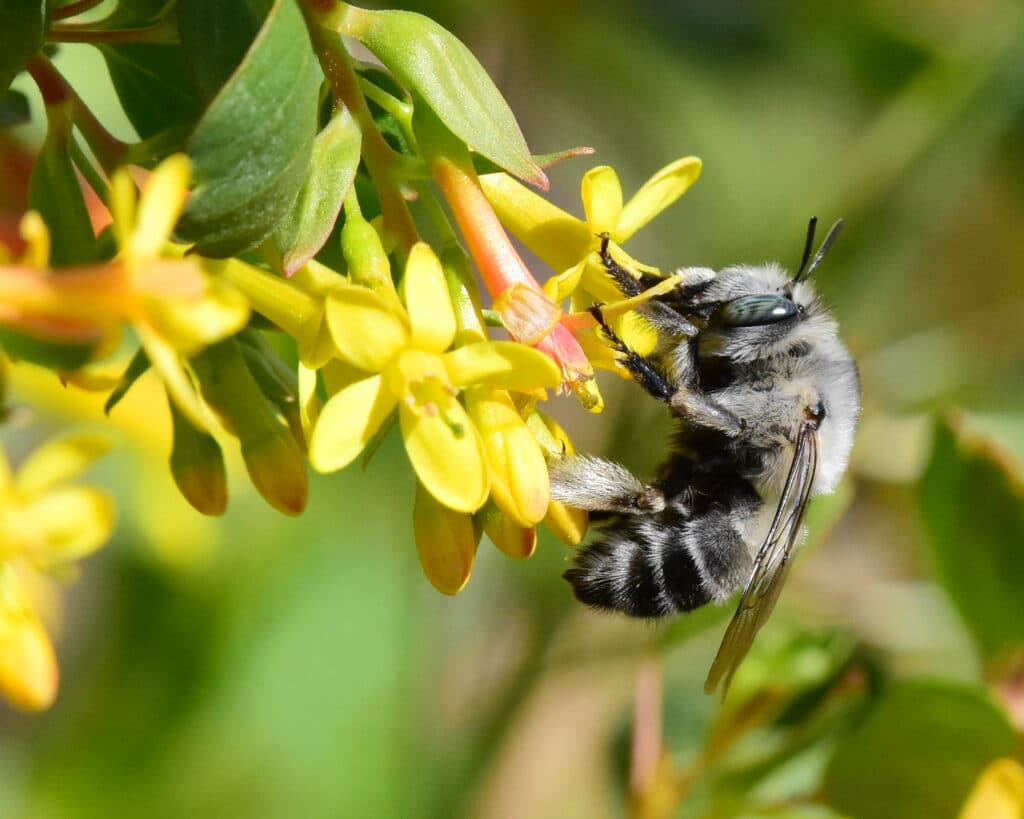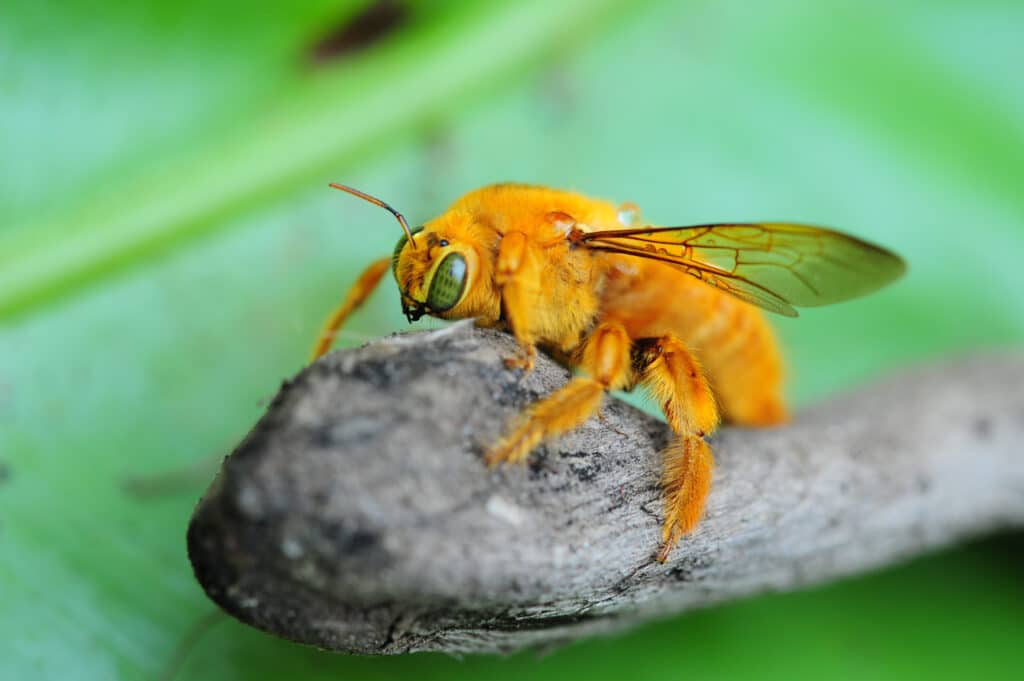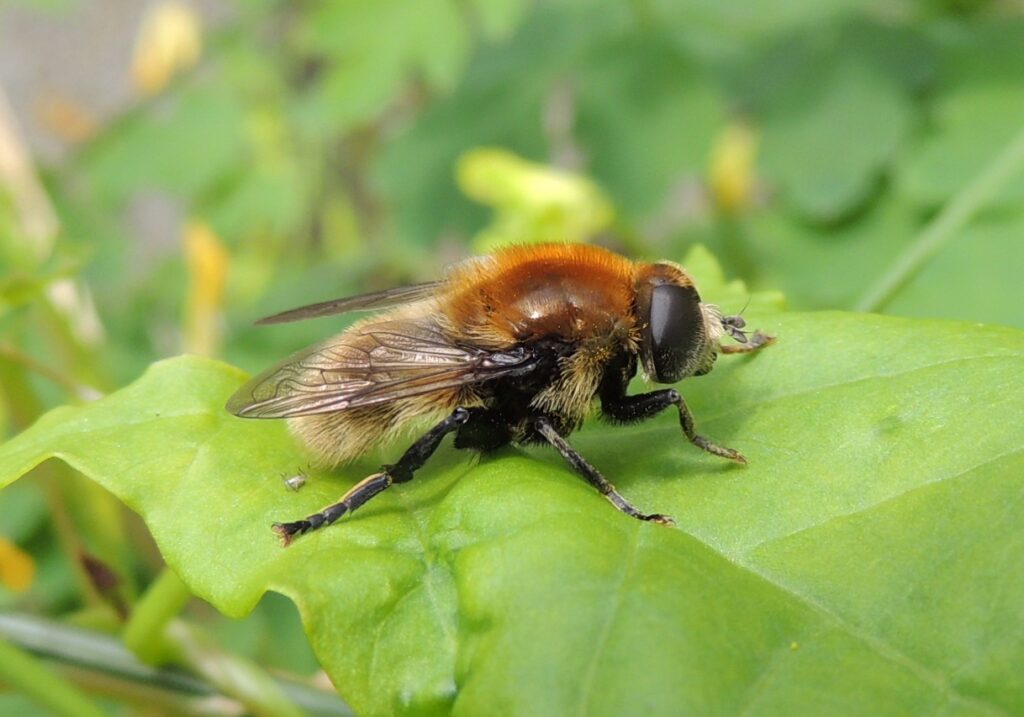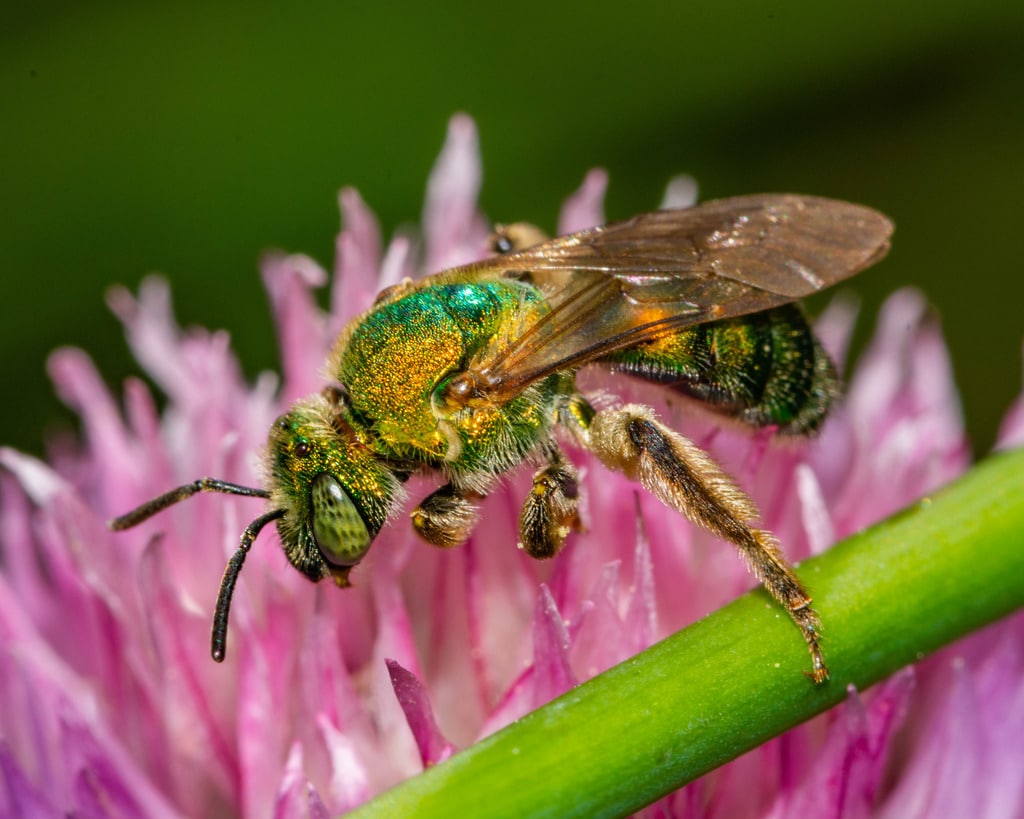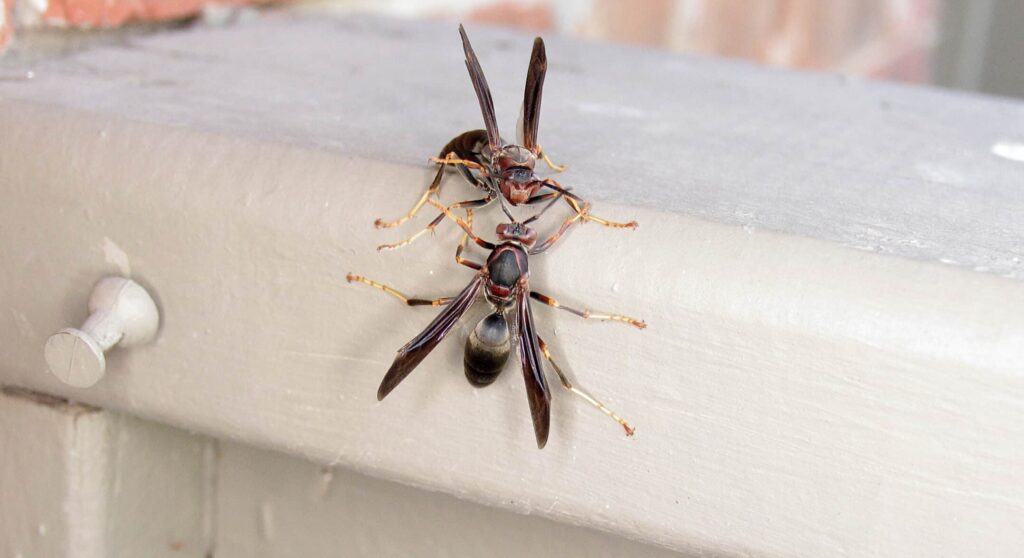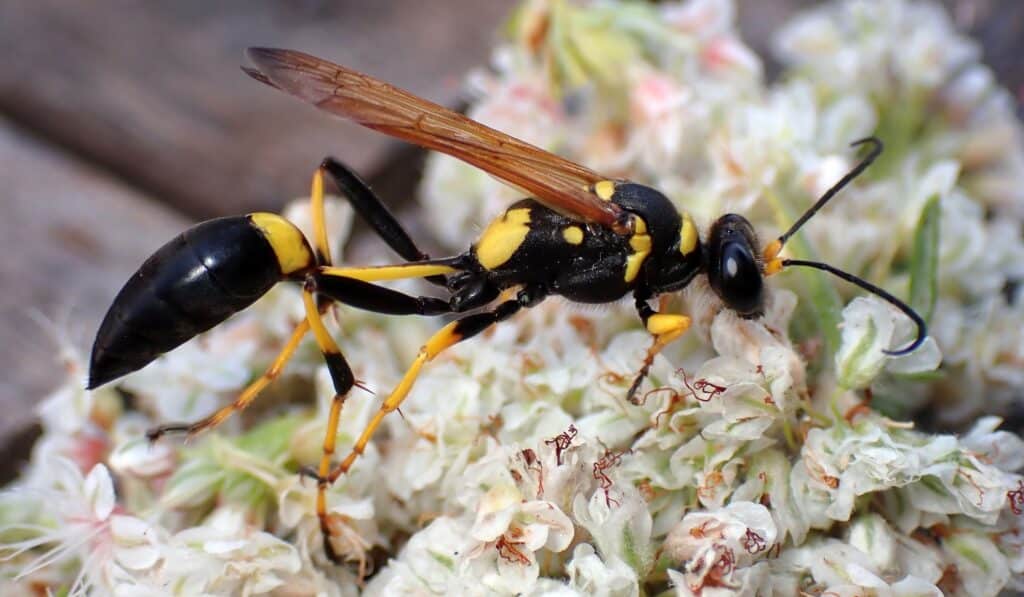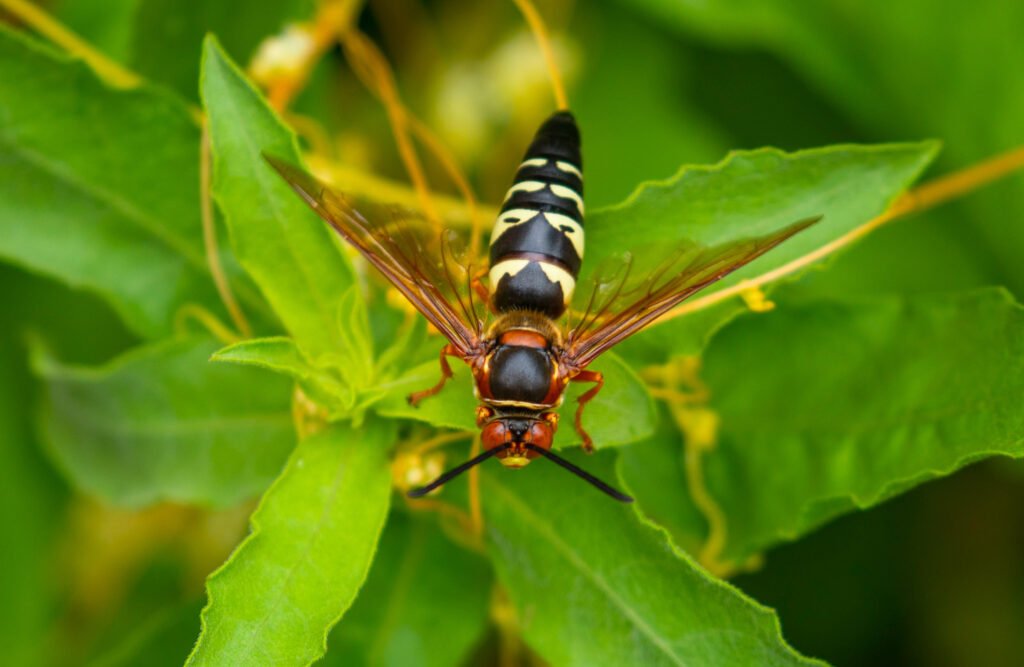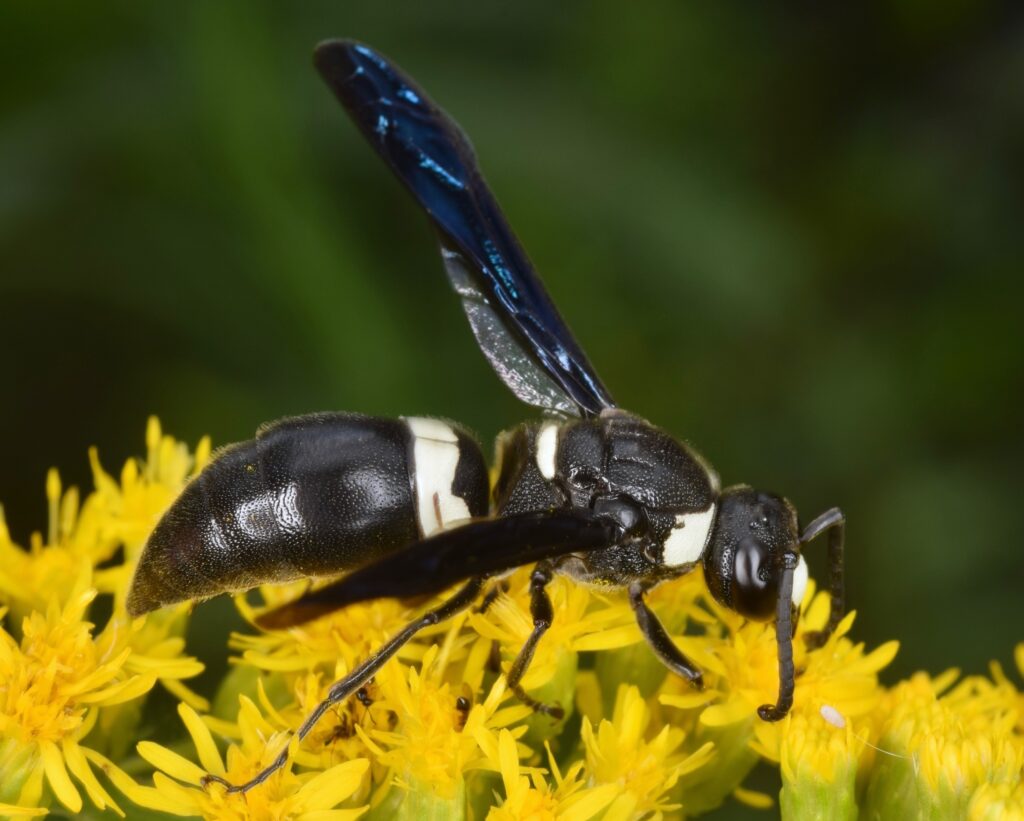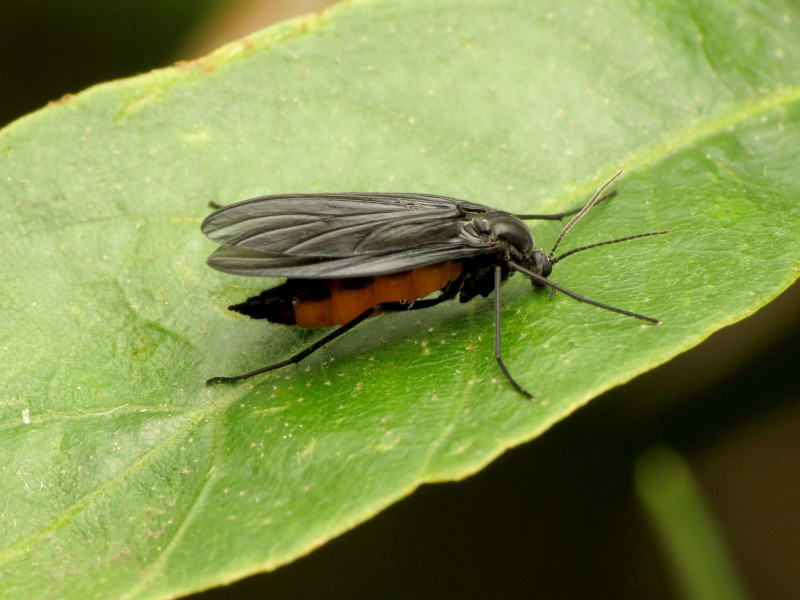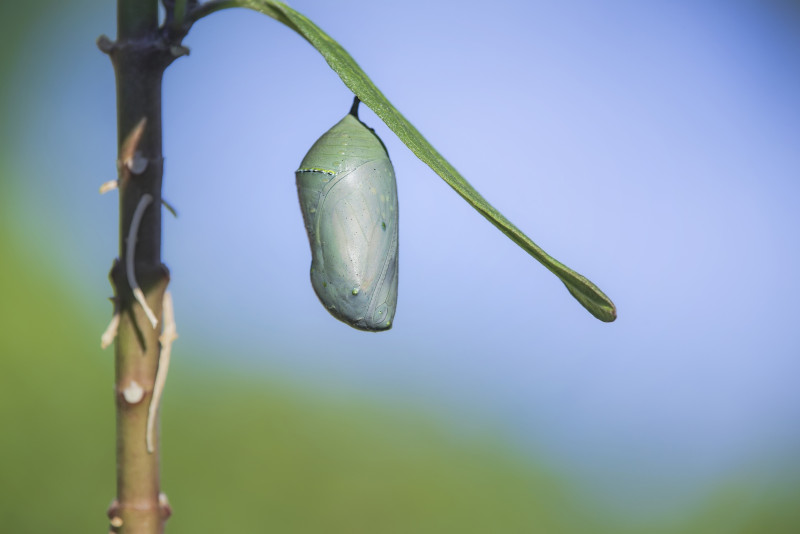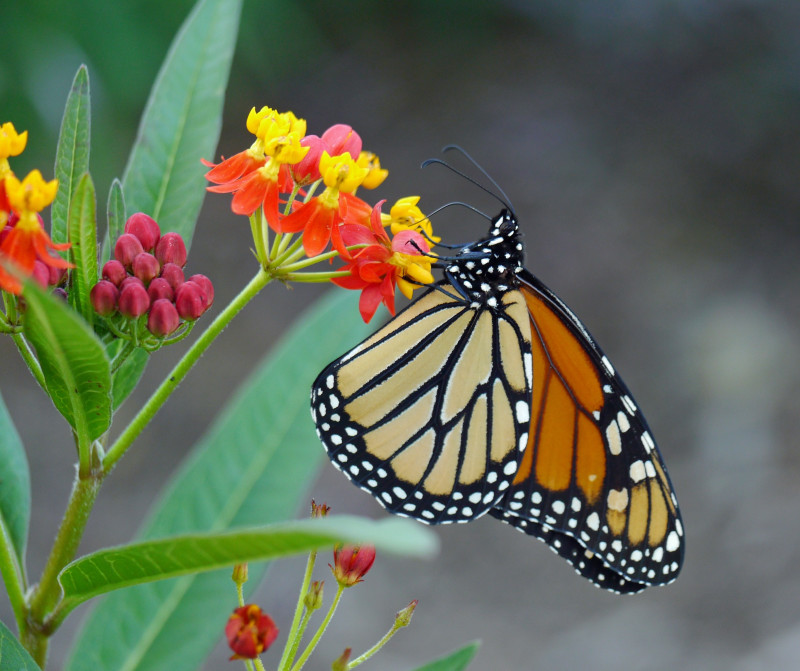Here are the bees and wasps you’re most likely to encounter in your yard. Although they make many people nervous, these insects don’t hate humans and aren’t inherently aggressive. You can co-exist and live safely with them. They just want to focus on foraging for food, caring for their young, and maintaining their nests. When left alone, they have little reason to sting. As proof, millions of gardeners regularly work safely and harmoniously alongside these insects in their yards and gardens. Only female bees and wasps sting, so many of those flying around are harmless males. Even if you don’t want to get too close to them, avoid using insecticides in your yard, as that will kill all other insects, too. Above all, try to appreciate their beauty and the benefits they contribute to making your yard a healthy wildlife habitat.
Simply be mindful of their presence, take certain precautions, and you’ll have no problems.
- Stay Calm: If you encounter a bee or wasp, be calm and move slowly away. Avoid sudden movements or swatting, which can make them think you’re attacking them.
- Give space to their nests or swarming areas. Be aware of the locations of wasp and bee nests and avoid disturbing them. If nests are in high-traffic areas, consider seeking professional assistance for safe removal.
- Avoid Strong Scents: Fragrances from perfumes, lotions, and even strong-smelling foods can attract them, so minimize the use of these products when spending time outdoors.
- Wear Neutral Colors: They tend to inspect bright colors and floral patterns, perhaps to see if they’re food, so opt for neutral-colored clothing.
- Cover Food and Drinks: When dining outdoors, cover food and drinks to prevent attracting them. Also, promptly clean up any spills.
Honeybee, aphis mellifera
Honeybees, renowned for their intricate social structure and remarkable intelligence, epitomize the marvels of the insect world. They exhibit astonishing cooperation within their colonies, where each member plays a vital role. They have a complex communication system and impressive cognitive abilities, displaying aptitude in problem-solving tasks and navigation over vast distances.
Worker bees can sting. However, they’re reluctant to do so because their stinger has a barbed hook on the end, which stays in the victim’s body, like a fishing hook. When they sting and fly away, the hook is yanked out of the bee, fatally injuring it. It’s safe to work in a garden with them buzzing around, but avoid beehives, which they tend to defend more aggressively. Originally native to Europe, Western Asia, and Africa, Honeybees are now found on every continent except Antarctica.
Bumblebee, Bombus spp.
There are about 250 bumblebee species, most of which inhabit the Northern Hemisphere. Like honeybees, they’re social insects that feed on nectar and collect pollen to feed their young. They’re beneficial pollinators that aren’t aggressive and seldom sting unless really provoked or their nest is threatened. They form colonies that are much smaller than those of honeybees, with as few as fifty members. Bumblebees are found throughout the U.S. and Canada, inhabiting diverse habitats from coast to coast, and from the northern reaches of Canada to the southern U.S. They also inhabit Europe, Asia, and some parts of South America.
Here’s how to tell honeybees and bumblebees apart: Honeybees tend to be slender and have a more pronounced pattern of stripes. Some bumblebees are bigger than honeybees, and some aren’t, but all are fuzzier and fatter and usually have blocks of color rather than a series of stripes.
Eastern Carpenter Bee, Xylocopa virginica
Carpenter Bees are typically black and yellow. The males are large—about 1.0-inch (25 mm) long—but don’t worry—they can’t sting, and the females seldom do. Their name comes from their behavior of burrowing holes into wood to place their nests. They can be destructive if they excavate year after year in the same tunnel system, but even then, the damage is rarely significant. These bees are beneficial because they pollinate as they move among plants, collecting pollen to feed their young. They’re most often seen in the eastern U.S. but can be found across the country and into southern Canada.
Digger Bees, family Apidae
Digger bees, also known as mining bees, are characterized by their robust bodies and dense hair. They range from black to shades of brown, grey, or even metallic hues. They’re typically medium to large in size, depending on the species. As they feed on a wide range of flowering plants, they’re helpful pollinators. Solitary in behavior, females construct individual nests by digging tunnels into sandy or loose soil and provision them with pollen and nectar before laying a single egg in each one. They’re found throughout N.A., Europe, and other parts of the world. Unaggressive, they rarely sting humans.
Valley Carpenter Bee, Xylocopa varipuncta
As if to prove not all carpenter bees are the typical black and yellow comes the pretty Valley Carpenter Bee, one of only three carpenter bee species found in the West, particularly southwestern states and California. The males are the bright color you see here, while the females are metallic black.
Honeybee or Bumblebee?
What do you think? Is the insect above a honeybee or a bumblebee? It’s neither! It’s a hoverfly that resembles a bumblebee, and it’s on this page because of its similarity. Bumblebees can sting, but hoverflies don’t, so looking like something dangerous is an advantage. There are six thousand species of them worldwide, and, as their name says, they hover as they feed on nectar and spread pollen. They’re harmless, don’t sting, and are very beneficial, some as pollinators and others as predators of pest insects, such as aphids.
Sweat Bee, family Halictidae
Sweat bees are named for their attraction to human sweat, which they sometimes lap up for its salt content. They’re small to medium-sized bees with varying colors, including metallic greens, blues, bronzes, and shades of black and brown. These bees are generalist pollinators that feed on nectar and pollen from a wide range of flowering plants. They’re solitary or semi-social insects. Some species nest individually in the ground or in hollow plant stems, while others may nest communally. Females construct their nests and provide them with pollen and nectar before laying eggs. Sweat bees are found worldwide, occurring on every continent except Antarctica. They’re known for their gentle nature and rarely sting humans, only doing so if they feel threatened or trapped. Their sting is generally mild.
Paper Nest Wasp, Polistes spp.
Known as “social wasps,” paper nest wasps live in colonies, much like honeybees, with a queen and her workers. They’re familiar to many people because they often nest near doors and windows. Adults feed on nectar and pollinate flowers as they move about. They also collect insects to feed their larvae. They’re found throughout the U.S. and Canada. They also inhabit South America, Europe, Africa, and Asia. Females can be aggressive and sting if they feel their nest is threatened. Otherwise, they aren’t interested in humans, so don’t swat and just remain still if one decides to look you over.
Yellow Jacket Wasps, Vespula spp.
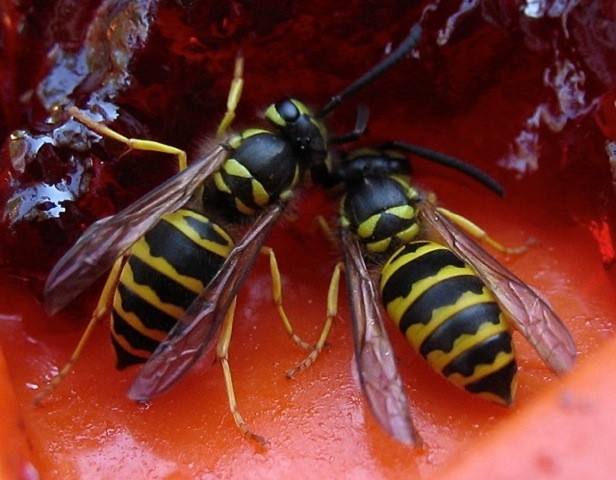
Eastern Yellow Jackets, Vespula maculifrons, feeding on grape jelly held in an oriole feeder (WW; CC BY-NC-SA 3.0)
Most yellow jacket wasps are so-called “social wasps” because they live in colonies, much like honeybees, with a queen and her workers. Their nests are usually underground but also found in places like building wall voids or ceilings. Most are black and yellow, but some have white faces and are sometimes confused with the Bald-faced Hornet. They’re beneficial as predators of insect pests. As their prey begins to disappear in the fall, they may set their sights on the sweet taste of sugar water in hummingbird feeders or, as shown above, grape jelly put out for orioles. They’re native to the U.S. and found across the continent, with different species having specific ranges. Don’t swat; they can repeatedly sting. Stay away from their nests.
Mud Dauber, genus Sceliphron
Mud dauber wasps are known for their slender bodies and distinctive elongated waists. Those in the genus Sceliphron are entirely black or black with yellow markings. Those in the genus Chalybion are a metallic blue-black color. Mud daubers are named for their habit of constructing their nests from mud, often in sheltered locations such as under eaves or in attics. The nests consist of multiple cylindrical chambers where the wasp lays its eggs and provisions them with paralyzed (primarily) spiders to feed their larvae. They’re valuable predators that help control spider populations, and they also drink nectar and sweet liquids from fruit, helping to pollinate. They’re found worldwide in regions across North and South America, Europe, Africa, Asia, and Australia. Generally unaggressive, they rarely sting unless provoked, but may defend their nests.
European Hornet, Vespa crabro
Striking for their large size and distinctive coloration, European Hornets are 0.9 to 1.3 inches (25 –35 mm) long, with a yellow and brownish-black striped abdomen. Their face has yellow markings. (There’s also a Bald-faced Hornet, Dolichovespula maculata, which has white markings.) They’re beneficial because they feed on flies, yellow jackets, hornets, and other insects, making them valuable predators of pest populations. They also help pollinate as they hunt for prey on flowers. Their nests are made of chewed-up paper-like materials and can grow quite large. Native to Europe and parts of Asia, they’ve been introduced into the eastern U.S. and limited regions of Canada. They’re not particularly aggressive toward humans, but if provoked or nest threatened, can deliver a painful sting.
Eastern Cicada Killer Wasp, Sphecius specious
Eastern Cicada Killer Wasps have a robust body adorned in black and yellow stripes, reminiscent of other wasp species. Very large, about 2 inches (51 mm) long, they primarily prey on cicadas. They’re considered beneficial to ecosystems due to their role in controlling cicada populations, which can sometimes cause damage to trees and shrubs. They live solitary lives and dig a nest in the ground to hold only themselves. They’re native to eastern N.A., from southern Canada to Mexico. Generally not aggressive toward humans, they typically only sting if directly handled or provoked.
Potter Wasps, family Eumeninae
Potter wasps, also known as mason wasps, vary in appearance depending on the species but are generally slender with elongated bodies and often display striking patterns of black, yellow, orange, or metallic colors. They’re solitary wasps named for their characteristic construction of small, vase-like nests made from mud, which resemble pottery or clay pots. These are usually noticed in such places as under eaves, in crevices, or on walls. Adults feed primarily on nectar and pollen. But they also hunt for various insects, such as caterpillars and spiders, which they place inside their nests as food for their developing larvae. They’re found worldwide, including the U.S. from Canada to Mexico. They aren’t typically aggressive toward humans and sting only if threatened. Their sting is usually mild.
All about honeybees
In your yard: bees, wasps, ants, sawflies
In your yard: mantises
Explore an insect-friendly yard

